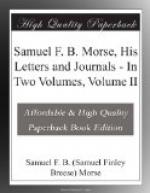Cornell proved himself, indeed, an efficient assistant, and much of the success of the enterprise, from that time forward, was due to his energy, quick-wittedness, and faithfulness.
Mr. Prime, in his biography of Morse, thus describes a dramatic episode of those trying days:—
“When the pipe had been laid as far as the Relay House, Professor Morse came to Mr. Cornell and expressed a desire to have the work arrested until he could try further experiments, but he was very anxious that nothing should be said or done to give to the public the impression that the enterprise had failed. Mr. Cornell said he could easily manage it, and, stepping up to the machine, which was drawn by a team of eight mules, he cried out: ’Hurrah, boys! we must lay another length of pipe before we quit.’ The teamsters cracked their whips over the mules and they started on a lively pace. Mr. Cornell grasped the handles of the plough, and, watching an opportunity, canted it so as to catch the point of a rock, and broke it to pieces while Professor Morse stood looking on.
“Consultations long and painful followed. The anxiety of Professor Morse at this period was greater than at any previous hour known in the history of the invention. Some that were around him had serious apprehensions that he would not stand up under the pressure.”
Cornell having thus cleverly cut the Gordian knot, it was decided to string wires on poles, and Cornell himself thus describes the solution of the insulation problem:—
“In the latter part of March Professor Morse gave me the order to put the wires on poles, and the question at once arose as to the mode of fastening the wires to the poles, and the insulation of them at the point of fastening. I submitted a plan to the Professor which I was confident would be successful as an insulating medium, and which was easily available then and inexpensive. Mr. Vail also submitted a plan for the same purpose, which involved the necessity of going to New York or New Jersey to get it executed. Professor Morse gave preference to Mr. Vail’s plan, and started for New York to get the fixtures, directing me to get the wire ready for use and arrange for setting the poles.
“At the end of a week Professor Morse returned from New York and came to the shop where I was at work, and said he wanted to provide the insulators for putting the wires on the poles upon the plan I had suggested; to which I responded: ’How is that, Professor; I thought you had decided to use Mr. Vail’s plan?’ Professor Morse replied: ’Yes, I did so decide, and on my way to New York, where I went to order the fixtures, I stopped at Princeton and called on my old friend, Professor Henry, who inquired how I was getting along with my Telegraph.
“’I explained to him the failure of the insulation in the pipes, and stated that I had decided to place the wires on poles in the air. He then inquired how I proposed to insulate the wires when they were attached to the poles. I showed him the model I had of Mr. Vail’s plan, and he said, “It will not do; you will meet the same difficulty you had in the pipes.” I then explained to him your plan which he said would answer.’”




